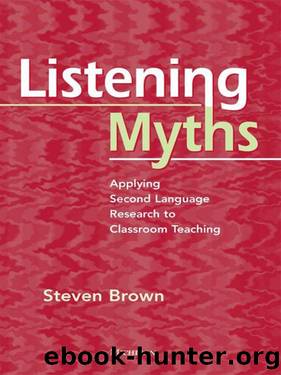Listening Myths by Steven Brown

Author:Steven Brown [Brown, Steven]
Language: eng
Format: epub
Publisher: University of Michigan Press
Published: 2013-04-24T00:00:00+00:00
Organizing Discourse: The Example of Lecture Listeningââ
One issue that comes up when the discussion turns to longer texts is the ways in which the discourse is organized. Within listening research, the subfield of academic listening has been especially interested in discourse markers. Discourse markers are not the only things that make listening to lectures challenging. As we have seen elsewhere in this book, rate of speech, vocabulary, background knowledge, and use of visuals are all potential factors in comprehension. Overall, Richards (1983) lists 18 micro-skills implicated in listening to academic lectures. It would be difficult to say which factor is most important. (See Chaudron, 1995, and Flowerdew, 1994, for overviews of academic listening.)
Listening to lectures is a demanding cognitive task. Understanding the content requires that students form an overall sense of the purpose of the lecture, the likely rhetorical form it's going to take (comparison/contrast, problem/solution), and recognize many main ideas and even more supporting details. The student also has to learn to edit out the asides and digressions that most lecturers include. To help them understand, students need to be aware of and make use of the techniques that lecturers use to organize their talks. Macro-markers like Today I want toâ¦, There are three things⦠serve to provide a general structure to the lecture. They are useful for separating main ideas from details and for getting a constantly updated representation of the topic. Micro-markers like OK, well, so operate at a more local level but are also important to understanding.
Chaudron and Richards (1986) looked at both macro- and micro-markers and their effect on lecture comprehension. They condensed a real lecture to seven pages of text and recorded the text. Subjects performed a clozed (fill in the blanks) recall of parts of the lecture at 90-second intervals and took two tests on the content of the lecture. Chaudron and Richards tested two groups of students, pre-university and academically admitted, divided into groups that heard the lecture enhanced with micro-markers, macro-markers, or both. Overall, macro-markers were more effective than micro-markers in facilitating comprehension.
Partially as a result of the early research on the efficacy of macro-markers, English for Academic Purposes (EAP) listening textbooks that prepare learners to succeed in English-medium universities have tended to focus on macro-markers at the expense of micro-markers, and perhaps for a good reason. Clerehan (1995) analyzed lecture notes from both English L1 and L2 learners in a law class in an Australian university. The L1 students recorded 99â100 percent of the main ideas in the lecture while the L2 students missed 19 percent of the main ideas and 34 percent of the ideas in the next level of idea organization, the subheadings. Clerehan suggests that they did not recognize the rhetorical structure of the lecture. If this were indeed the case, educating them as to the possible discourse markers that signpost lectures might be effective, as would teaching some common ways that speakers organize lectures. The subjects in Tauroza and Allison's (1994) study of an electrical engineering
Download
This site does not store any files on its server. We only index and link to content provided by other sites. Please contact the content providers to delete copyright contents if any and email us, we'll remove relevant links or contents immediately.
| Arts & Humanities | Health |
| Language Arts | Library Skills |
| Mathematics | Reading & Phonics |
| Science & Technology | Social Studies |
The Art of Coaching Workbook by Elena Aguilar(51004)
Trainspotting by Irvine Welsh(21524)
Twilight of the Idols With the Antichrist and Ecce Homo by Friedrich Nietzsche(18515)
Fangirl by Rainbow Rowell(9109)
Periodization Training for Sports by Tudor Bompa(8176)
Change Your Questions, Change Your Life by Marilee Adams(7641)
This Is How You Lose Her by Junot Diaz(6804)
Asking the Right Questions: A Guide to Critical Thinking by M. Neil Browne & Stuart M. Keeley(5664)
Grit by Angela Duckworth(5526)
Red Sparrow by Jason Matthews(5392)
Paper Towns by Green John(5094)
Room 212 by Kate Stewart(5041)
Ken Follett - World without end by Ken Follett(4648)
Housekeeping by Marilynne Robinson(4349)
The Sports Rules Book by Human Kinetics(4304)
Double Down (Diary of a Wimpy Kid Book 11) by Jeff Kinney(4210)
Papillon (English) by Henri Charrière(4200)
The Motorcycle Diaries by Ernesto Che Guevara(4021)
Exercise Technique Manual for Resistance Training by National Strength & Conditioning Association(3965)
